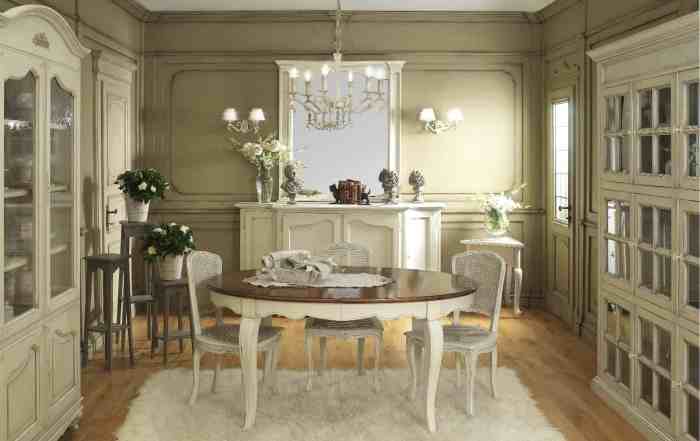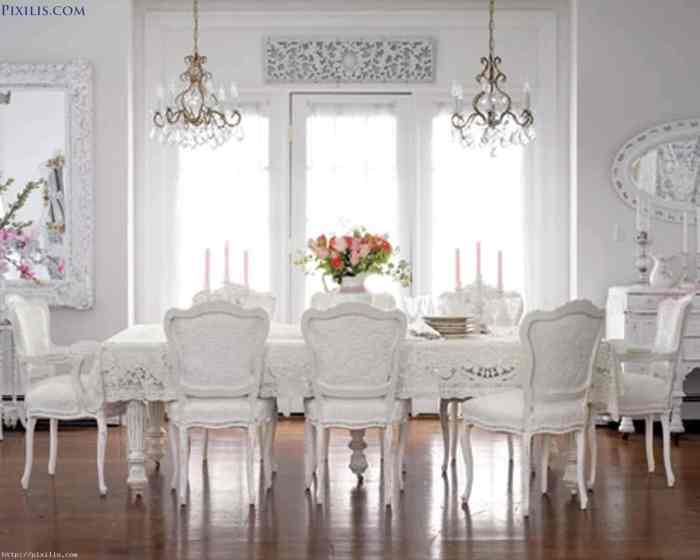Crafting a Timeless Appeal: Shabby Chic Interior Design
Embark on a journey through the enchanting world of shabby chic interior design, where vintage charm meets modern elegance. Delve into the key elements and rich history that define this unique style, setting the stage for a captivating exploration ahead.
Introduction to Shabby Chic Interior Design
Shabby Chic interior design is a style that embraces a worn, lived-in look while still maintaining an elegant and cozy atmosphere. This design aesthetic combines vintage elements with soft, pastel colors and a mix of textures to create a charming and romantic space.
Key Elements of Shabby Chic Style
- Distressed Furniture: Pieces with worn edges and peeling paint are common in shabby chic design, adding a touch of rustic charm.
- Soft Color Palette: Soft pastel hues like pale pink, mint green, and powder blue are often used to create a light and airy feel.
- Mix of Textures: Combining different textures such as lace, linen, and floral patterns adds depth and interest to the space.
- Vintage Accents: Incorporating vintage pieces like chandeliers, mirrors, and delicate china adds a touch of nostalgia to the design.
History and Origins of Shabby Chic Design
Shabby Chic design originated in the 1980s when designer Rachel Ashwell popularized the term. Inspired by the worn and faded look of antique furniture, Ashwell began incorporating these elements into her designs, creating a new style that focused on comfort and elegance.
Color Palette in Shabby Chic Design
Shabby chic interiors are known for their soft, romantic, and vintage-inspired color palettes that create a cozy and inviting atmosphere. The typical color palette used in shabby chic design includes muted pastel tones, such as pale pink, soft blue, mint green, lavender, and creamy whites.
These colors help to evoke a sense of nostalgia and femininity, contributing to the overall charm of the space.
Use of Pastel Colors vs. Bold Colors
In shabby chic design, pastel colors are predominantly favored over bold and vibrant hues. Pastel colors create a sense of serenity and airiness, making the space feel light and welcoming. Bold colors, on the other hand, can be used sparingly as accents to add a pop of color and create visual interest.
For example, a pastel pink room with a bold emerald green velvet sofa can create a striking contrast while maintaining the shabby chic aesthetic.
Impact of Color Choices on Shabby Chic Aesthetic
The choice of colors in shabby chic design can greatly impact the overall aesthetic of the space. Soft pastel tones contribute to a romantic and vintage feel, while also enhancing the shabby chic style's signature distressed and weathered furniture pieces.
On the other hand, incorporating bold colors can add a modern twist to the traditional shabby chic look, creating a more eclectic and personalized space. Whether opting for a soft pastel palette or introducing bold accents, the color choices in shabby chic design play a crucial role in setting the mood and ambiance of the room.
Furniture and Decor in Shabby Chic Style
Shabby chic interiors are known for their charming and eclectic mix of furniture and decor pieces that exude a vintage, romantic, and lived-in feel.
Characteristics of Furniture in Shabby Chic Interiors
- Distressed finishes: Furniture in shabby chic style often features distressed paint or finishes to create a weathered look.
- Soft, pastel colors: Soft and muted pastel colors like pale pink, mint green, and baby blue are commonly used in shabby chic furniture.
- Feminine details: Furniture pieces are often adorned with feminine details such as floral motifs, ruffles, and lace.
- Mix of styles: Shabby chic interiors embrace a mix of styles, incorporating pieces from different eras for an eclectic look.
How Vintage Pieces are Incorporated
Vintage pieces play a crucial role in achieving the shabby chic look. They add character and history to the space, giving it a unique and personalized touch.
Where to Find Unique Furniture and Decor Items
Thrift stores, flea markets, antique shops, and online marketplaces like Etsy are great places to find one-of-a-kind furniture and decor items for a shabby chic look. Keep an eye out for pieces with intricate details, distressed finishes, and a romantic flair to enhance your shabby chic interior.
Textiles and Fabrics in Shabby Chic Decor

When it comes to shabby chic decor, textiles and fabrics play a crucial role in adding texture, charm, and a cozy feel to the space. From delicate lace to vintage floral prints and distressed fabrics, the right textiles can truly enhance the shabby chic aesthetic of a room.
Importance of Textiles in Shabby Chic Design
- Lace: Lace fabric is a staple in shabby chic decor, adding a touch of elegance and femininity to the space. It can be used for curtains, tablecloths, or even as accents on pillows.
- Floral Prints: Vintage floral prints on fabrics bring a romantic and nostalgic feel to shabby chic interiors. Mixing and matching different floral patterns can create a whimsical and eclectic look.
- Distressed Fabrics: Distressed fabrics like faded linens or weathered denim add a worn-in and lived-in charm to shabby chic decor. They provide a sense of comfort and casual elegance to the space.
Mixing and Matching Textiles for a Cohesive Look
- When combining different textiles in shabby chic design, consider sticking to a soft and muted color palette to maintain a cohesive look.
- Mix textures like lace, chenille, and cotton to add depth and dimension to the space while keeping the overall aesthetic harmonious.
- Don't be afraid to layer fabrics by using different patterns and materials on pillows, throws, and upholstery to create a cozy and inviting atmosphere.
Incorporating Textiles into Various Elements of the Room
- Curtains: Use lace or floral printed curtains to bring a touch of vintage charm to the windows. Sheer fabrics can let in natural light while adding a softening effect to the room.
- Pillows: Decorative pillows with lace trims, ruffles, or floral patterns can instantly elevate the look of a sofa or bed in a shabby chic style.
- Upholstery: Opt for distressed fabrics or slipcovers in light colors to transform furniture pieces into shabby chic statement pieces. Mixing different textures can add visual interest and a cozy feel to the room.
DIY Projects for Achieving a Shabby Chic Look
Transforming a space into a shabby chic paradise can be achieved through simple do-it-yourself projects. Upcycling furniture and creating shabby chic decor pieces can add a unique and vintage touch to your home.
Upcycling Furniture
Upcycling furniture is a great way to incorporate shabby chic style into your home. Consider distressing a wooden table or chair to give it a weathered look. You can also paint old dressers in pastel colors or add floral patterns for a charming touch.
Distressed Picture Frames
- Start with a plain wooden picture frame.
- Apply a base coat of paint in a light, pastel color.
- Once dry, lightly sand the edges and corners to create a distressed look.
- For an added touch, glue on decorative embellishments like vintage keys or lace trim.
Vintage-Inspired Wall Art
- Find an old window frame or wooden plank.
- Paint it in a soft, muted color like white or light blue.
- Attach vintage-inspired prints or fabric using Mod Podge for a decoupage effect.
- Hang the piece on your wall for a unique and personalized shabby chic decor.
Epilogue

As we draw the curtains on our discussion of shabby chic interior design, it's evident that this aesthetic offers a perfect blend of nostalgia and sophistication. Embrace the art of blending old and new, creating a space that exudes warmth and character, truly making a house feel like a home.
Essential FAQs
What defines shabby chic interior design?
Shabby chic interior design combines vintage elements with a touch of elegance, creating a cozy and lived-in look.
How can I incorporate vintage pieces into a shabby chic design?
You can scour flea markets, thrift stores, and antique shops for unique vintage furniture and decor items to add character to your space.
What are some common color choices in shabby chic interiors?
Soft pastel colors like pale pink, mint green, and powder blue are often used in shabby chic design to create a light and airy feel.
What DIY projects can help achieve a shabby chic look?
Simple projects like distressing furniture, creating vintage-inspired wall art, and repurposing old items can add that shabby chic charm to your space.